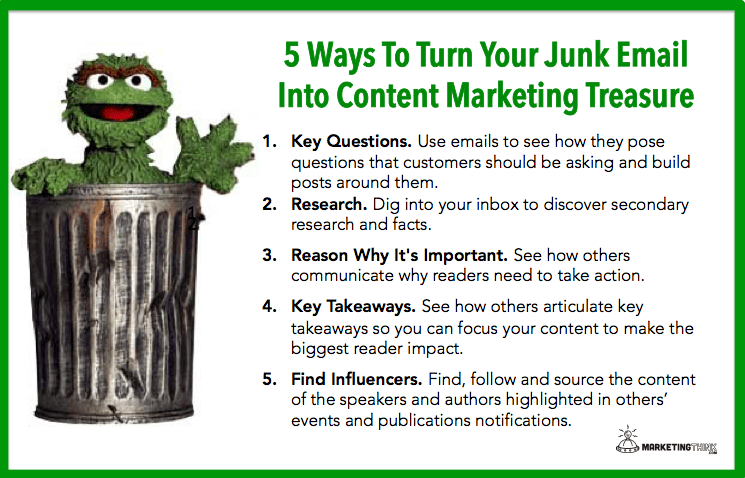I read all of my email. Even some email that some would say junk. It’s a great source of content marketing strategy.
One man’s ‘junk’ email is another man’s content marketing ‘treasure.’ You just need to embrace the ‘Oscar The Grouch editorial manager’ in you!
Over 100 billion emails sent and received daily – opt-in email newsletters and updates, cold-call inquiries, customer service follow-ups or just plain old emails for which you did not ask. With all of that email there is bound to be a research, infographic or value proposition treasure if you dig deep into your digital trash can. Sesame Street’s own Oscar The Grouch used to say, “This is where I wanna be – junk (email) paradise! Just look it at. It’s like a work of (content marketing) art.”
For years, I automatically deleted all of these messages to avoid trudging through my inbox … someone else’s digital destination stuffed with their priorities. However, when I created my blog, MarketingThink.com, I changed my tune and started to read each email to look for content gold – interesting statistics, infographics, and questions I should be asking or answering. Now, every piece of email has the potential to inform me and support my blogging and content marketing lessons – helping me connect my audience with great ideas and statistics.
5 Ways To Use Your Junk Email For Content Marketing
No matter the industry, to whom you market or sell, solicitation or ‘junk’ emails typically have 5 things in common of which you can take advantage:
1. Key Questions. Use emails to see how they pose questions that customers should be asking and build posts around them. Asking questions is one of the best attention-getting techniques brands use – especially for blog titles. Prospects and customers are drawn in with the questions they should ask since it helps them frame their challenges and opportunities. Read your emails and leverage these questions – turning them into a blog post of your own with your own point of view.
2. Research. Dig into your inbox to discover secondary research and facts. Few companies can afford to conduct primary research. However, most people select quality secondary facts and figures at their fingertips – opted-in and unsolicited emails. Look under the hood of your email inbox to find the relevant research facts to hook the reader and craft your message. These numbers and graphics can help you set up a customer trigger to incite a response – a moment of fear, or why a particular issue should warrant extra concern or consideration. My advice … always to double-check your referenced facts and sources.
3. Reason Why It’s Important. See how others communicate why readers need to take action. See how others articulate reasons why readers need to take action on the key question or piece of research and incorporate that into your content’s call to action! See how others articulate reasons why readers need to take action on the key question or piece of research and incorporate that into your content’s call to action! Somewhere in the body of a good solicitation email, a statement identifies why attending the event or downloading the asset is valuable. These ‘reasons why’ are a great blog post starter. Remember, the most important blog posts speak specifically to one issue. If you have more than one point to make, then create another blog post!
4. Key Takeaways. See how others articulate key takeaways so you can focus your content to make the biggest reader impact. A good solicitation email highlights something similar to “You Will Learn These 5 Things By Attending (or downloading.)” Whether it is your own company email or another’s this subject call-out is a great guide for you to create focused content that articulates your point of view. In other words, what will the reader learn by reading your blog post or e-book? Yes, you can blatantly point out to the reader the takeaways from your content!
5. Find Influencers. Find, follow, and source the speaker’s and authors’ content highlighted in others’ events and publications notifications. If you are looking to follow or source the content of a 1st-, 2nd, or 3rd-tier influencer for your content curation strategy, then research and follow the relevant speakers referenced in others’ emails. These speakers are typically active on social media, blog and create content that you can curate or spark ideas.
Whenever you are using statistics or key information to support your blogs or writing, make sure to attribute the contributing source – it shows good manners and lends to your credibility.
Do you have another source of content or reference materials that have been inspiring or added to the quality of your content marketing strategy? If so, please share below. Or contact me at gerry@marketingthink.com.
So, before you throw away that next email because your email inbox is filled to the brim, remember what Oscar The Grouch would do if he were your editorial manager — he’d make content marketing art out of the emails found in his junk folder.


